+ Open data
Open data
- Basic information
Basic information
| Entry | Database: EMDB / ID: EMD-30462 | |||||||||
|---|---|---|---|---|---|---|---|---|---|---|
| Title | Human Origin Recognition Complex, ORC2-5 | |||||||||
 Map data Map data | ||||||||||
 Sample Sample |
| |||||||||
 Keywords Keywords | DNA replication initiation / Origin Recognition Complex (ORC) / cryo-EM / autoinhibition conformation / REPLICATION | |||||||||
| Function / homology |  Function and homology information Function and homology informationpolar body extrusion after meiotic divisions / CDC6 association with the ORC:origin complex / origin recognition complex / E2F-enabled inhibition of pre-replication complex formation / nuclear origin of replication recognition complex / inner kinetochore / nuclear pre-replicative complex / DNA replication preinitiation complex / neural precursor cell proliferation / regulation of DNA replication ...polar body extrusion after meiotic divisions / CDC6 association with the ORC:origin complex / origin recognition complex / E2F-enabled inhibition of pre-replication complex formation / nuclear origin of replication recognition complex / inner kinetochore / nuclear pre-replicative complex / DNA replication preinitiation complex / neural precursor cell proliferation / regulation of DNA replication / DNA replication origin binding / protein polymerization / DNA replication initiation / Activation of the pre-replicative complex / glial cell proliferation / Activation of ATR in response to replication stress / heterochromatin / Assembly of the ORC complex at the origin of replication / Assembly of the pre-replicative complex / Orc1 removal from chromatin / chromosome, telomeric region / DNA replication / nuclear body / nucleotide binding / centrosome / chromatin / nucleolus / negative regulation of transcription by RNA polymerase II / ATP hydrolysis activity / nucleoplasm / ATP binding / nucleus / membrane / cytosol Similarity search - Function | |||||||||
| Biological species |  Homo sapiens (human) Homo sapiens (human) | |||||||||
| Method | single particle reconstruction / cryo EM / Resolution: 3.8 Å | |||||||||
 Authors Authors | Cheng J / Li N | |||||||||
| Funding support |  China, 1 items China, 1 items
| |||||||||
 Citation Citation |  Journal: Cell Discov / Year: 2020 Journal: Cell Discov / Year: 2020Title: Structural insight into the assembly and conformational activation of human origin recognition complex. Authors: Jiaxuan Cheng / Ningning Li / Xiaohan Wang / Jiazhi Hu / Yuanliang Zhai / Ning Gao /  Abstract: The function of the origin recognition complex (ORC) in DNA replication is highly conserved in recognizing and marking the initiation sites. The detailed molecular mechanisms by which human ORC is ...The function of the origin recognition complex (ORC) in DNA replication is highly conserved in recognizing and marking the initiation sites. The detailed molecular mechanisms by which human ORC is reconfigured into a state competent for origin association remain largely unknown. Here, we present structural characterizations of human ORC1-5 and ORC2-5 assemblies. ORC2-5 exhibits a tightly autoinhibited conformation with the winged-helix domain of ORC2 completely blocking the central DNA-binding channel. The binding of ORC1 partially relieves the autoinhibitory effect of ORC2-5 through remodeling ORC2-WHD, which makes ORC2-WHD away from the central channel creating a still autoinhibited but more dynamic structure. In particular, the AAA+ domain of ORC1 is highly flexible to sample a variety of conformations from inactive to potentially active states. These results provide insights into the detailed mechanisms regulating the autoinhibition of human ORC and its subsequent activation for DNA binding. | |||||||||
| History |
|
- Structure visualization
Structure visualization
| Movie |
 Movie viewer Movie viewer |
|---|---|
| Structure viewer | EM map:  SurfView SurfView Molmil Molmil Jmol/JSmol Jmol/JSmol |
| Supplemental images |
- Downloads & links
Downloads & links
-EMDB archive
| Map data |  emd_30462.map.gz emd_30462.map.gz | 97.2 MB |  EMDB map data format EMDB map data format | |
|---|---|---|---|---|
| Header (meta data) |  emd-30462-v30.xml emd-30462-v30.xml emd-30462.xml emd-30462.xml | 17.3 KB 17.3 KB | Display Display |  EMDB header EMDB header |
| Images |  emd_30462.png emd_30462.png | 149.1 KB | ||
| Filedesc metadata |  emd-30462.cif.gz emd-30462.cif.gz | 7 KB | ||
| Archive directory |  http://ftp.pdbj.org/pub/emdb/structures/EMD-30462 http://ftp.pdbj.org/pub/emdb/structures/EMD-30462 ftp://ftp.pdbj.org/pub/emdb/structures/EMD-30462 ftp://ftp.pdbj.org/pub/emdb/structures/EMD-30462 | HTTPS FTP |
-Validation report
| Summary document |  emd_30462_validation.pdf.gz emd_30462_validation.pdf.gz | 544.7 KB | Display |  EMDB validaton report EMDB validaton report |
|---|---|---|---|---|
| Full document |  emd_30462_full_validation.pdf.gz emd_30462_full_validation.pdf.gz | 544.3 KB | Display | |
| Data in XML |  emd_30462_validation.xml.gz emd_30462_validation.xml.gz | 6.6 KB | Display | |
| Data in CIF |  emd_30462_validation.cif.gz emd_30462_validation.cif.gz | 7.7 KB | Display | |
| Arichive directory |  https://ftp.pdbj.org/pub/emdb/validation_reports/EMD-30462 https://ftp.pdbj.org/pub/emdb/validation_reports/EMD-30462 ftp://ftp.pdbj.org/pub/emdb/validation_reports/EMD-30462 ftp://ftp.pdbj.org/pub/emdb/validation_reports/EMD-30462 | HTTPS FTP |
-Related structure data
| Related structure data |  7cteMC  7ctfC  7ctgC C: citing same article ( M: atomic model generated by this map |
|---|---|
| Similar structure data |
- Links
Links
| EMDB pages |  EMDB (EBI/PDBe) / EMDB (EBI/PDBe) /  EMDataResource EMDataResource |
|---|---|
| Related items in Molecule of the Month |
- Map
Map
| File |  Download / File: emd_30462.map.gz / Format: CCP4 / Size: 103 MB / Type: IMAGE STORED AS FLOATING POINT NUMBER (4 BYTES) Download / File: emd_30462.map.gz / Format: CCP4 / Size: 103 MB / Type: IMAGE STORED AS FLOATING POINT NUMBER (4 BYTES) | ||||||||||||||||||||||||||||||||||||||||||||||||||||||||||||
|---|---|---|---|---|---|---|---|---|---|---|---|---|---|---|---|---|---|---|---|---|---|---|---|---|---|---|---|---|---|---|---|---|---|---|---|---|---|---|---|---|---|---|---|---|---|---|---|---|---|---|---|---|---|---|---|---|---|---|---|---|---|
| Projections & slices | Image control
Images are generated by Spider. | ||||||||||||||||||||||||||||||||||||||||||||||||||||||||||||
| Voxel size | X=Y=Z: 0.8286 Å | ||||||||||||||||||||||||||||||||||||||||||||||||||||||||||||
| Density |
| ||||||||||||||||||||||||||||||||||||||||||||||||||||||||||||
| Symmetry | Space group: 1 | ||||||||||||||||||||||||||||||||||||||||||||||||||||||||||||
| Details | EMDB XML:
CCP4 map header:
| ||||||||||||||||||||||||||||||||||||||||||||||||||||||||||||
-Supplemental data
- Sample components
Sample components
-Entire : Human Origin Recognition Complex 2-5
| Entire | Name: Human Origin Recognition Complex 2-5 |
|---|---|
| Components |
|
-Supramolecule #1: Human Origin Recognition Complex 2-5
| Supramolecule | Name: Human Origin Recognition Complex 2-5 / type: complex / ID: 1 / Parent: 0 / Macromolecule list: #1-#4 |
|---|---|
| Source (natural) | Organism:  Homo sapiens (human) Homo sapiens (human) |
-Macromolecule #1: Origin recognition complex subunit 2
| Macromolecule | Name: Origin recognition complex subunit 2 / type: protein_or_peptide / ID: 1 / Number of copies: 1 / Enantiomer: LEVO |
|---|---|
| Source (natural) | Organism:  Homo sapiens (human) Homo sapiens (human) |
| Molecular weight | Theoretical: 66.063375 KDa |
| Recombinant expression | Organism:  |
| Sequence | String: MSKPELKEDK MLEVHFVGDD DVLNHILDRE GGAKLKKERA QLLVNPKKII KKPEYDLEED DQEVLKDQNY VEIMGRDVQE SLKNGSATG GGNKVYSFQN RKHSEKMAKL ASELAKTPQK SVSFSLKNDP EITINVPQSS KGHSASDKVQ PKNNDKSEFL S TAPRSLRK ...String: MSKPELKEDK MLEVHFVGDD DVLNHILDRE GGAKLKKERA QLLVNPKKII KKPEYDLEED DQEVLKDQNY VEIMGRDVQE SLKNGSATG GGNKVYSFQN RKHSEKMAKL ASELAKTPQK SVSFSLKNDP EITINVPQSS KGHSASDKVQ PKNNDKSEFL S TAPRSLRK RLIVPRSHSD SESEYSASNS EDDEGVAQEH EEDTNAVIFS QKIQAQNRVV SAPVGKETPS KRMKRDKTSD LV EEYFEAH SSSKVLTSDR TLQKLKRAKL DQQTLRNLLS KVSPSFSAEL KQLNQQYEKL FHKWMLQLHL GFNIVLYGLG SKR DLLERF RTTMLQDSIH VVINGFFPGI SVKSVLNSIT EEVLDHMGTF RSILDQLDWI VNKFKEDSSL ELFLLIHNLD SQML RGEKS QQIIGQLSSL HNIYLIASID HLNAPLMWDH AKQSLFNWLW YETTTYSPYT EETSYENSLL VKQSGSLPLS SLTHV LRSL TPNARGIFRL LIKYQLDNQD NPSYIGLSFQ DFYQQCREAF LVNSDLTLRA QLTEFRDHKL IRTKKGTDGV EYLLIP VDN GTLTDFLEKE EEEA UniProtKB: Origin recognition complex subunit 2 |
-Macromolecule #2: Origin recognition complex subunit 3
| Macromolecule | Name: Origin recognition complex subunit 3 / type: protein_or_peptide / ID: 2 / Number of copies: 1 / Enantiomer: LEVO |
|---|---|
| Source (natural) | Organism:  Homo sapiens (human) Homo sapiens (human) |
| Molecular weight | Theoretical: 82.365055 KDa |
| Recombinant expression | Organism:  |
| Sequence | String: MATSSMSKGC FVFKPNSKKR KISLPIEDYF NKGKNEPEDS KLRFETYQLI WQQMKSENER LQEELNKNLF DNLIEFLQKS HSGFQKNSR DLGGQIKLRE IPTAALVLGV NVTDHDLTFG SLTEALQNNV TPYVVSLQAK DCPDMKHFLQ KLISQLMDCC V DIKSKEEE ...String: MATSSMSKGC FVFKPNSKKR KISLPIEDYF NKGKNEPEDS KLRFETYQLI WQQMKSENER LQEELNKNLF DNLIEFLQKS HSGFQKNSR DLGGQIKLRE IPTAALVLGV NVTDHDLTFG SLTEALQNNV TPYVVSLQAK DCPDMKHFLQ KLISQLMDCC V DIKSKEEE SVHVTQRKTH YSMDSLSSWY MTVTQKTDPK MLSKKRTTSS QWQSPPVVVI LKDMESFATK VLQDFIIISS QH LHEFPLI LIFGIATSPI IIHRLLPHAV SSLLCIELFQ SLSCKEHLTT VLDKLLLTTQ FPFKINEKVL QVLTNIFLYH DFS VQNFIK GLQLSLLEHF YSQPLSVLCC NLPEAKRRIN FLSNNQCENI RRLPSFRRYV EKQASEKQVA LLTNERYLKE ETQL LLENL HVYHMNYFLV LRCLHKFTSS LPKYPLGRQI RELYCTCLEK NIWDSEEYAS VLQLLRMLAK DELMTILEKC FKVFK SYCE NHLGSTAKRI EEFLAQFQSL DETKEEEDAS GSQPKGLQKT DLYHLQKSLL EMKELRRSKK QTKFEVLREN VVNFID CLV REYLLPPETQ PLHEVVYFSA AHALREHLNA APRIALHTAL NNPYYYLKNE ALKSEEGCIP NIAPDICIAY KLHLECS RL INLVDWSEAF ATVVTAAEKM DANSATSEEM NEIIHARFIR AVSELELLGF IKPTKQKTDH VARLTWGGC UniProtKB: Origin recognition complex subunit 3 |
-Macromolecule #3: Origin recognition complex subunit 4
| Macromolecule | Name: Origin recognition complex subunit 4 / type: protein_or_peptide / ID: 3 / Number of copies: 1 / Enantiomer: LEVO |
|---|---|
| Source (natural) | Organism:  Homo sapiens (human) Homo sapiens (human) |
| Molecular weight | Theoretical: 50.44425 KDa |
| Recombinant expression | Organism:  |
| Sequence | String: MSSRKSKSNS LIHTECLSQV QRILRERFCR QSPHSNLFGV QVQYKHLSEL LKRTALHGES NSVLIIGPRG SGKTMLINHA LKELMEIEE VSENVLQVHL NGLLQINDKI ALKEITRQLN LENVVGDKVF GSFAENLSFL LEALKKGDRT SSCPVIFILD E FDLFAHHK ...String: MSSRKSKSNS LIHTECLSQV QRILRERFCR QSPHSNLFGV QVQYKHLSEL LKRTALHGES NSVLIIGPRG SGKTMLINHA LKELMEIEE VSENVLQVHL NGLLQINDKI ALKEITRQLN LENVVGDKVF GSFAENLSFL LEALKKGDRT SSCPVIFILD E FDLFAHHK NQTLLYNLFD ISQSAQTPIA VIGLTCRLDI LELLEKRVKS RFSHRQIHLM NSFGFPQYVK IFKEQLSLPA EF PDKVFAE KWNENVQYLS EDRSVQEVLQ KHFNISKNLR SLHMLLMLAL NRVTASHPFM TAVDLMEASQ LCSMDSKANI VHG LSVLEI CLIIAMKHLN DIYEEEPFNF QMVYNEFQKF VQRKAHSVYN FEKPVVMKAF EHLQQLELIK PMERTSGNSE REYQ LMKLL LDNTQIMNAL QKYPNCPTDV RQWATSSLSW L UniProtKB: Origin recognition complex subunit 4 |
-Macromolecule #4: Origin recognition complex subunit 5
| Macromolecule | Name: Origin recognition complex subunit 5 / type: protein_or_peptide / ID: 4 / Number of copies: 1 / Enantiomer: LEVO |
|---|---|
| Source (natural) | Organism:  Homo sapiens (human) Homo sapiens (human) |
| Molecular weight | Theoretical: 50.349934 KDa |
| Recombinant expression | Organism:  |
| Sequence | String: MPHLENVVLC RESQVSILQS LFGERHHFSF PSIFIYGHTA SGKTYVTQTL LKTLELPHVF VNCVECFTLR LLLEQILNKL NHLSSSEDG CSTEITCETF NDFVRLFKQV TTAENLKDQT VYIVLDKAEY LRDMEANLLP GFLRLQELAD RNVTVLFLSE I VWEKFRPN ...String: MPHLENVVLC RESQVSILQS LFGERHHFSF PSIFIYGHTA SGKTYVTQTL LKTLELPHVF VNCVECFTLR LLLEQILNKL NHLSSSEDG CSTEITCETF NDFVRLFKQV TTAENLKDQT VYIVLDKAEY LRDMEANLLP GFLRLQELAD RNVTVLFLSE I VWEKFRPN TGCFEPFVLY FPDYSIGNLQ KILSHDHPPE YSADFYAAYI NILLGVFYTV CRDLKELRHL AVLNFPKYCE PV VKGEASE RDTRKLWRNI EPHLKKAMQT VYLREISSSQ WEKLQKDDTD PGQLKGLSAH THVELPYYSK FILIAAYLAS YNP ARTDKR FFLKHHGKIK KTNFLKKHEK TSNHLLGPKP FPLDRLLAIL YSIVDSRVAP TANIFSQITS LVTLQLLTLV GHDD QLDGP KYKCTVSLDF IRAIARTVNF DIIKYLYDFL UniProtKB: Origin recognition complex subunit 5 |
-Macromolecule #5: ADENOSINE-5'-TRIPHOSPHATE
| Macromolecule | Name: ADENOSINE-5'-TRIPHOSPHATE / type: ligand / ID: 5 / Number of copies: 2 / Formula: ATP |
|---|---|
| Molecular weight | Theoretical: 507.181 Da |
| Chemical component information |  ChemComp-ATP: |
-Experimental details
-Structure determination
| Method | cryo EM |
|---|---|
 Processing Processing | single particle reconstruction |
| Aggregation state | particle |
- Sample preparation
Sample preparation
| Buffer | pH: 7.6 |
|---|---|
| Vitrification | Cryogen name: ETHANE |
- Electron microscopy
Electron microscopy
| Microscope | FEI TITAN KRIOS |
|---|---|
| Image recording | Film or detector model: GATAN K2 SUMMIT (4k x 4k) / Average electron dose: 65.0 e/Å2 |
| Electron beam | Acceleration voltage: 300 kV / Electron source:  FIELD EMISSION GUN FIELD EMISSION GUN |
| Electron optics | Illumination mode: FLOOD BEAM / Imaging mode: BRIGHT FIELD |
| Experimental equipment |  Model: Titan Krios / Image courtesy: FEI Company |
 Movie
Movie Controller
Controller



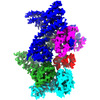




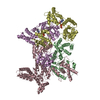
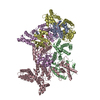

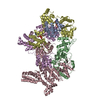
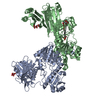



 Z (Sec.)
Z (Sec.) Y (Row.)
Y (Row.) X (Col.)
X (Col.)





















